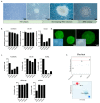Gene Editing Correction of a Urea Cycle Defect in Organoid Stem Cell Derived Hepatocyte-like Cells
- PMID: 33530582
- PMCID: PMC7865883
- DOI: 10.3390/ijms22031217
Gene Editing Correction of a Urea Cycle Defect in Organoid Stem Cell Derived Hepatocyte-like Cells
Abstract
Urea cycle disorders are enzymopathies resulting from inherited deficiencies in any genes of the cycle. In severe cases, currently available therapies are marginally effective, with liver transplantation being the only definitive treatment. Donor liver availability can limit even this therapy. Identification of novel therapeutics for genetic-based liver diseases requires models that provide measurable hepatic functions and phenotypes. Advances in stem cell and genome editing technologies could provide models for the investigation of cell-based genetic diseases, as well as the platforms for drug discovery. This report demonstrates a practical, and widely applicable, approach that includes the successful reprogramming of somatic cells from a patient with a urea cycle defect, their genetic correction and differentiation into hepatic organoids, and the subsequent demonstration of genetic and phenotypic change in the edited cells consistent with the correction of the defect. While individually rare, there is a large number of other genetic-based liver diseases. The approach described here could be applied to a broad range and a large number of patients with these hepatic diseases where it could serve as an in vitro model, as well as identify successful strategies for corrective cell-based therapy.
Keywords: CRISPR; disease modelling; genome editing; hepatocytes; iPSC; urea cycle.
Conflict of interest statement
S.C.S. hold stocks in Yecuris, LLC. The funders had no role in the design of the study; in the collection, analyses, or interpretation of data; in the writing of the manuscript, or in the decision to publish the results.
Figures






References
-
- Summar M.L., Koelker S., Freedenberg D., Le Mons C., Haberle J., Lee H.S., Kirmse B., European Registry. Network for Intoxication Type Metabolic Diseases. Members of the Urea Cycle Disorders Consortium The incidence of urea cycle disorders. Mol. Genet. Metab. 2013;110:179–180. doi: 10.1016/j.ymgme.2013.07.008. - DOI - PMC - PubMed
-
- Stephenne X., Najimi M., Smets F., Reding R., de Ville de Goyet J., Sokal E.M. Cryopreserved liver cell transplantation controls ornithine transcarbamylase deficient patient while awaiting liver transplantation. Am. J. Transplant. 2005;5:2058–2061. doi: 10.1111/j.1600-6143.2005.00935.x. - DOI - PubMed
-
- Meyburg J., Das A.M., Hoerster F., Lindner M., Kriegbaum H., Engelmann G., Schmidt J., Ott M., Pettenazzo A., Luecke T., et al. One liver for four children: First clinical series of liver cell transplantation for severe neonatal urea cycle defects. Transplantation. 2009;87:636–641. doi: 10.1097/TP.0b013e318199936a. - DOI - PubMed
MeSH terms
Substances
Grants and funding
LinkOut - more resources
Full Text Sources
Other Literature Sources
Medical

